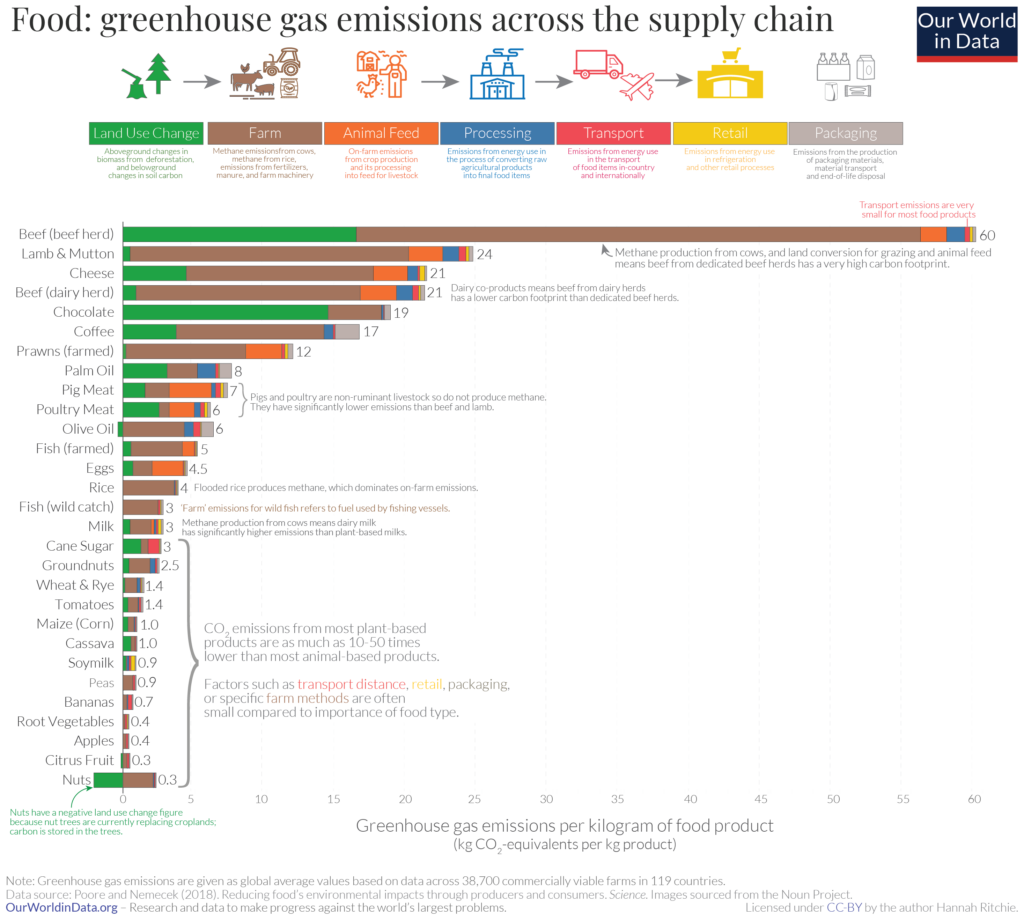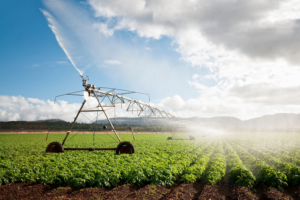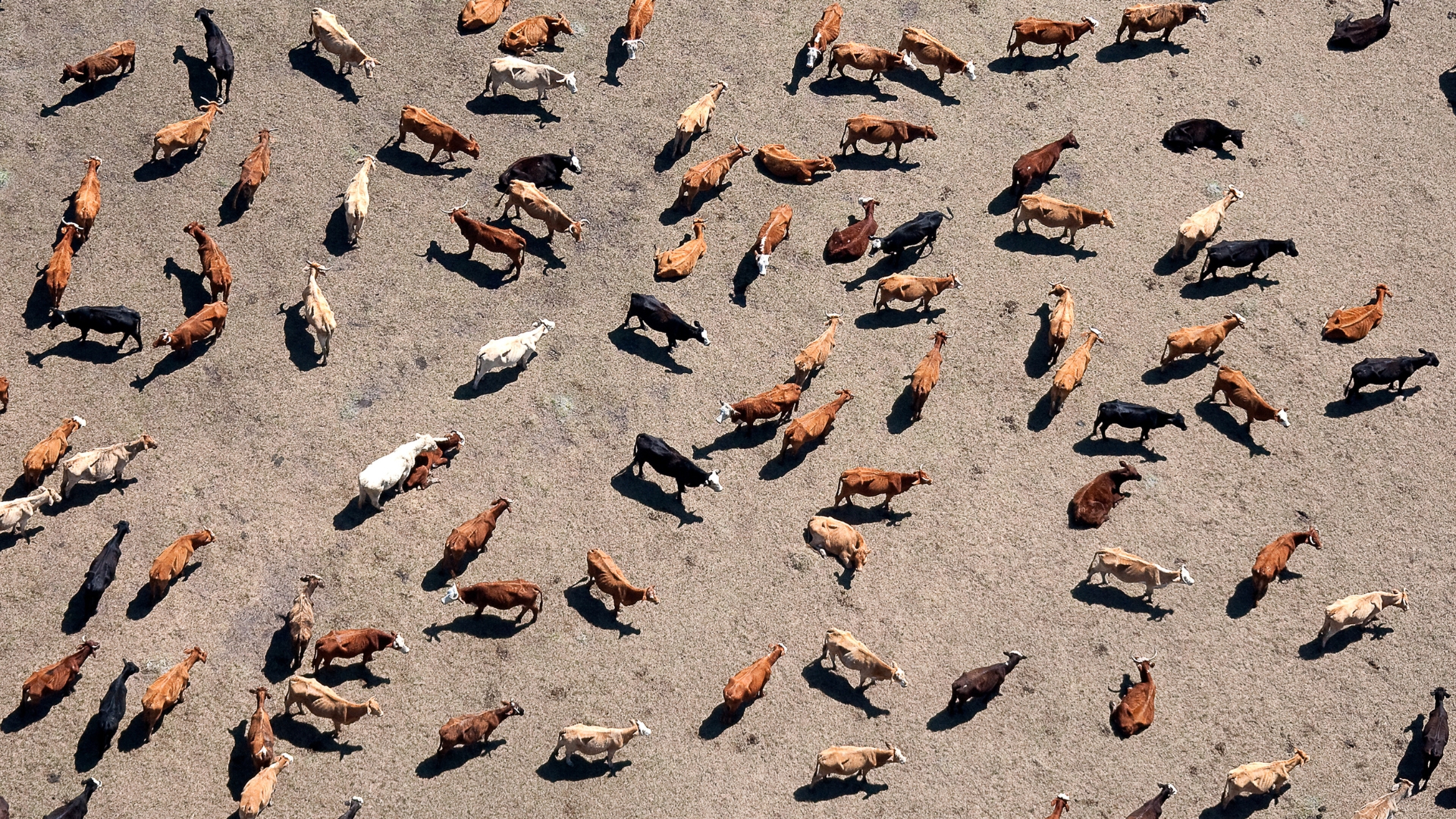We need to talk about our food footprint
Written by Olivia Nater | Published: April 4, 2024
Our numbers, what we choose to eat, and how much food we waste, have a huge impact on our planet. Global food systems are leading drivers of our environmental crises, including climate change, water overextraction, deforestation, biodiversity loss, and pollution. Shrinking our food footprint is a prerequisite to a livable future.
A tragic waste
 The UN’s Food Waste Index Report 2024 published last week revealed that the world threw away over one billion tons of food in 2022. This represents one-fifth of food available at the retail, food service, and household level and doesn’t include the food that already goes to waste at the supply chain level. In total, approximately one-third of all produced food is wasted.
The UN’s Food Waste Index Report 2024 published last week revealed that the world threw away over one billion tons of food in 2022. This represents one-fifth of food available at the retail, food service, and household level and doesn’t include the food that already goes to waste at the supply chain level. In total, approximately one-third of all produced food is wasted.
Households were responsible for 631 million tons of food waste, representing as much as 60 percent of the waste generated at the consumer level, and equivalent to approximately one billion meals per day. The report highlights the folly of such waste when an estimated 783 million people around the world don’t have enough to eat.
But there is another reason we should be concerned about food waste: global food production is destroying our environment.
Food during the Great Acceleration
Modern agriculture is rooted in the Green Revolution, which began in the 1960s and involved dramatically intensifying food production to try to keep up with our exploding population. It represented a shift from small-scale, relatively low-impact farming to high-impact, intensive farming aided by technology and massive amounts of irrigation, fertilizers, and pesticides. The Green Revolution is widely touted as a huge success story because it helped avert mass starvation, but its downsides are often ignored – the industrialization of our food production came at a dire cost to the environment.
Climate impact
Our food systems emit roughly one-third of global greenhouse gas emissions, which is why scientists say that meeting climate targets requires a major transformation of food production and diets. In fact, a 2020 study showed that without changes to our global food system, even if all emissions from fossil fuels were eliminated immediately, we would not be able to meet the Paris Agreement goal of limiting warming to 1.5° to 2°C.
According to Project Drawdown, slashing food waste and reducing meat and dairy consumption are the top two solutions for keeping global warming under 2°C, based on the number of tons of emissions they would prevent by 2050. The third most effective solution is slowing population growth.
Different foods have vastly different climate footprints – beef in particular stands out, emitting 60 kilograms (kg) of CO2-equivalent greenhouse gases for every 1 kg of meat produced, largely due to methane, a particularly potent greenhouse gas. In contrast, corn, soymilk, and bananas each emit 1 kg or less of greenhouse gases for every 1 kg of food produced. Of course, it’s worth keeping in mind that 1 kg of bananas contains a lot fewer calories than 1 kg of beef.

The expansion of crops and grazing land is responsible for almost 90 percent of deforestation, which has negative climate implications due to the removal of key carbon sinks and intentional fire setting.
Biodiversity impact
An estimated one million species are sliding toward extinction, and the destruction of natural habitats is the leading cause. With almost half (45 percent) of the world’s habitable land being used for agriculture, food production is a major driver of biodiversity loss. Rearing livestock, especially cattle, uses the most land – a staggering 80 percent of all agricultural land, including feed crops and pasture, is used to produce meat and dairy.
Intensive pesticide use is devastating invertebrate populations – exposure during crop application and through the consumption of contaminated nectar and pollen can kill and harm key pollinators, while pesticide runoff from farms pollutes water bodies and kills aquatic invertebrates. The decimation of insect populations has in turn led to the decline of birds that depend on them for food. Manure and fertilizer runoff also damages aquatic ecosystems by causing harmful algal blooms.
Water impact
 The combination of population growth, climate change, and increasing meat consumption poses a huge risk to global water supplies. Worldwide, agriculture accounts for around 70 percent of all freshwater withdrawals, while an estimated 41 percent of agricultural water is used to grow livestock feed. In some watersheds, the proportion of water used for livestock farming is even higher. For example, a recent study revealed that cattle-feed crops consume 46 percent of all the water that is diverted from the Colorado River.
The combination of population growth, climate change, and increasing meat consumption poses a huge risk to global water supplies. Worldwide, agriculture accounts for around 70 percent of all freshwater withdrawals, while an estimated 41 percent of agricultural water is used to grow livestock feed. In some watersheds, the proportion of water used for livestock farming is even higher. For example, a recent study revealed that cattle-feed crops consume 46 percent of all the water that is diverted from the Colorado River.
Unsurprisingly, when looking at the water footprint of different foods, beef is once again the elephant in the room, requiring around 15,400 liters of water for every kg of meat, while vegetables need on average just 300 liters per kg. Nuts are also very water-intensive to produce, requiring around 9,000 liters per kilogram of food, followed by sheep and goat meat, pork, and dairy, respectively.
Reducing our food footprint
When facing the facts, it is impossible to deny that we need to massively transform our food systems. We already have the solutions at hand, the most impactful being reducing food waste and transitioning to more plant-heavy diets, especially in Global North countries with very high per capita consumption of animal products.
In light of the growing demand for food due to population growth, and particularly for meat as a result of rising incomes across emerging economies, we also need to stabilize our population through empowering solutions as soon as is possible.
At an individual level, we can take action by ensuring we don’t waste food at home or when eating out, and by avoiding the highest-impact foods, such as beef. A more sustainable food future is within reach – let’s make it happen.

